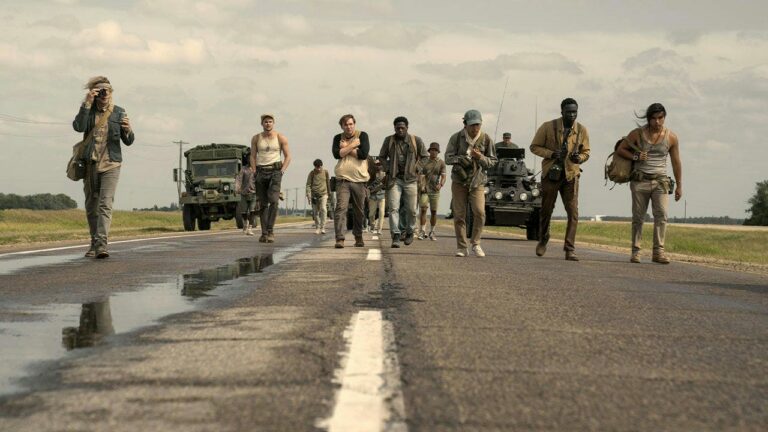
The Genesis of ‘The Long Walk’: From Page to Screen
Stephen King, the master of horror, has crafted countless tales that have haunted readers for decades. While his bibliography is extensive, ‘The Long Walk’ holds a special place as the first novel he ever wrote. Born from the creative fires of the Vietnam War era, this book is a key to understanding King’s unique perspective on the world. The film adaptation, directed by Francis Lawrence and written by JT Mollner, stays true to the source material, allowing the story to unfold on the big screen in a powerful and relevant way. The film adaptation seeks to bring the raw essence of King’s original novel to life, promising a cinematic experience that captures the same blend of tension, horror, and profound human drama.
The core of ‘The Long Walk’ remains unchanged: a competition where young men must walk. The rules are simple, yet brutal: maintain a pace of at least three miles per hour, or face the consequences. The film adaptation uses this simple premise to explore complex themes of survival, desperation, and the human spirit under extreme duress. The Major, a character embodying a distorted view of masculinity and individualism, oversees the walk. He becomes a symbol of the societal forces that drive this grim event. As the story unfolds, the walkers’ bodies and minds are pushed to their limits, and the story shifts into a battle of survival. The adaptation highlights the gruesome realities of the walk. The director’s approach ensures that the audience is never fully comfortable, and we are forced to consider the violence. Even without explicit gore, the film uses the walkers’ reactions to emphasize the psychological toll. The film adaptation holds a mirror to the audience, inviting them to grapple with the bleak reality of the competition.
The Grim Reality of ‘The Long Walk’
The narrative of ‘The Long Walk’ is characterized by a relentless pace and a stark presentation of violence. The film adaptation does not shy away from these elements. The director takes his time with the story, allowing the tension to build slowly. Every drop of rain, every stumble, and every physical challenge becomes a matter of life and death. The film underscores the emotional weight. The audience is forced to face the harsh reality of the walk. This approach serves a purpose, making the viewers complicit in the story. It’s a conscious decision to immerse the audience in the same sense of dread and resignation that the walkers experience.
The violence, however, is not gratuitous; instead, it underscores the story’s core message. The audience is compelled to reflect on the normalization of violence. It challenges the audience to confront the dark side of humanity. The film makes it clear that violence is not the only horror in the story. The audience is pushed to ponder questions about society and human nature. The film does not offer easy answers. Instead, it invites a deeper reflection on the themes of the story.
Exploring Themes: Friendship, Despair, and Societal Critique
The film uses the simple premise to explore various themes of human struggle. At its core, ‘The Long Walk’ explores the relationships between the walkers. The film highlights the importance of companionship. The bond between Ray Garraty and Peter McVries becomes the core of the film. Their connection becomes a source of strength and hope amidst the despair. The story delves into their shared moments of joy and moments of struggle. The performances of Cooper Hoffman and David Jonsson are central to the film’s emotional impact. Their naturalism adds a layer of realism to their characters. The support and kindness between them contrast starkly with the overall bleakness of the walk. Their camaraderie is a testament to the human spirit’s resilience. The narrative underscores the value of connection and support in extreme circumstances.
The film also uses the competition to critique society. The rules of the walk symbolize the forces that drive the walkers. Characters like Barkovitch embody the nihilistic outlook of some participants. Stebbins, a silent contender, shows the futility of hope. The Major, a representation of societal values, becomes a symbol of indifference. The film poses uncomfortable questions about society. It provokes the audience to examine the forces that shape human behavior. The film prompts viewers to question their own beliefs and values. It is a powerful reminder of the human capacity for both cruelty and compassion.
The Adaptation: Strengths and Weaknesses
The adaptation of ‘The Long Walk’ offers a faithful and thought-provoking take on King’s novel. The film adaptation keeps the spirit of the book alive. Judy Greer’s portrayal of Ginny Garraty is another highlight, adding emotional depth to the story. The film is not without its weaknesses. Some characters do not get the development they deserve. The film could have been more concise in some areas. The repetition of the deaths, while thematically relevant, might make the film feel longer for some viewers. Despite these issues, the adaptation is an overall success. The strength of the film lies in its willingness to explore difficult themes. The film highlights the value of friendship, even when facing despair. The film’s themes give it a powerful resonance that will linger with viewers long after the credits roll.
Conclusion: A Bleak, Yet Powerful Journey
In conclusion, ‘The Long Walk’ is a harrowing cinematic experience. The adaptation of King’s novel successfully captures the bleakness and brutality of the story. Hoffman and Jonsson’s performances give the film its emotional core. The film’s exploration of friendship and kindness shines brightly. Despite the repetitive nature of the walk, the adaptation remains a powerful piece of cinema. The film prompts introspection about the human condition and the forces at play in our world. The film leaves a lasting impression. Ultimately, ‘The Long Walk’ is a testament to the enduring power of storytelling. It is a film that will haunt viewers and invite them to ponder the darkness and light within the human experience. The film does not offer easy answers, but the journey is worth taking.



